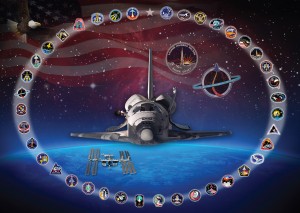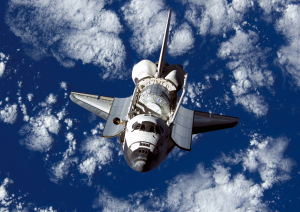TUESDAY, 24 APRIL 2012
After a year of decommissioning, NASA’s flagship Space Shuttle Discovery has made its final flight, this time within Earth’s atmosphere to its retirement home at the Smithsonian National Air and Space Museum’s Steven F. Udvar Hazy Center, in Chantilly, Virginia. Piggy-backing on one of NASA’s two specially-modified Boeing 747 Shuttle Aircraft Carriers, Discovery made the 4-hour journey from Florida’s Kennedy Space Centre to Dulles International Airport just outside Washington, DC, landing safely on 17th April after a tour around the capital.The Smithsonian won the right to Discovery’s retirement last year after campaigns from a number of museums and educational institutions across the United States to host the orbiters. The prototype shuttle, Enterprise, which has been at the Smithsonian since 1985, will soon be moved to the Intrepid Sea, Air and Space Museum in New York, to make way for Discovery. Once decommissioning is complete later this year, the youngest shuttle, Endeavour, will move to the California Science Center in Los Angeles, while Atlantis will remain at the Kennedy Space Center Visitor Complex as a tribute to the hard work and dedication of the staff who built their careers around the shuttle program. NASA will also distribute many other shuttle artifacts, including offering heat-shield tiles to space-enthused schools.
Discovery is the oldest remaining orbiter of the Space Shuttle fleet, making its maiden voyage into space in 1984. During its 27 years of service, Discovery made a record 39 trips into space, travelling nearly a quarter of a million kilometers and carrying more than 200 astronauts. Among its notable payloads, Discovery launched the Hubble Space Telescope in 1990, and played a fundamental part in the construction of the International Space Station (ISS), which has now maintained a constant human presence in orbit for over ten years. Discovery’s final flight concluded in March last year after a mission to deliver supplies, an additional work/storage module, and the ‘Robonaut2’ robotic helper. When it returned from space for the last time, Discovery had spent a cumulative 365 days in orbit; more than any other space craft built.
Although the Space Shuttle program was criticized for escalating costs and plagued with safety concerns after the tragic loss of the Challenger and Columbia orbiters, it has been an icon of human space exploration and has inspired a generation of scientists, engineers and astronauts. Commercial businesses are set to assume responsibility for ferrying astronauts and cargo into Low Earth Orbit, with the first test-docking of SpaceX’s as yet unmanned ‘Dragon’ capsule to the ISS expected to take place at the end of April. Meanwhile, NASA’s attention has turned further afield to the Moon and Mars, with testing of its ‘Orion Multi-Purpose Crew Vehicle’ underway. While the retirement of the shuttle is a sad time for many at NASA and also for its fans worldwide, the program has taught us many important lessons about manned space flight, and the shuttle may yet have an important part to play in our continued exploration of the stars.
Written by Vicki Moignard


